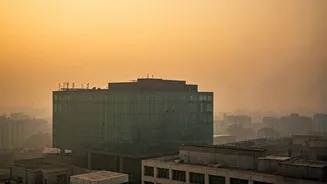Hazardous Air Quality
The air quality in Delhi, along with several cities in Haryana, has dropped to a 'hazardous' level. The Air Quality Index (AQI) in certain areas has reached
almost 600, indicating severe air pollution. This surge in pollution poses significant health risks to the residents of Delhi and surrounding regions. The worsening air quality is a significant concern, requiring urgent attention and immediate action to protect public health. The situation is not only a local crisis but also raises broader environmental concerns, highlighting the need for comprehensive strategies to improve air quality and mitigate the harmful effects of pollution. This requires a thorough analysis of the contributing factors and the implementation of effective measures. The hazardous levels indicate that the air poses a threat to the respiratory system and overall health. With AQI values near 600, the air can cause immediate health issues and exacerbate existing conditions. This necessitates awareness and timely steps from both the government and the individuals to reduce the impact of the air pollution.
Factors at Play
Several factors contribute to the deteriorating air quality in Delhi. Among the most prominent are farm fires in Punjab, which release large amounts of smoke into the atmosphere. The impact of the fires is amplified by the weather conditions and other pollution sources. These factors combine to create a dangerous cocktail of airborne pollutants, impacting Delhi and nearby regions. The impact of stubble burning, though significant, is often compounded by local sources of pollution, including vehicular emissions and industrial activities. Each of these contributes to the overall pollution, with the combination making the air even more hazardous. The complex interplay of these factors demands a holistic approach to address the air quality issues. The situation necessitates a multi-faceted approach, tackling the various sources of pollution. Understanding these factors is key to implementing effective and sustainable solutions. The government, along with different organizations, should collaborate to develop methods for the control of pollution.
Affected Regions
The impact of the hazardous air quality is not limited to Delhi alone. Several cities in Haryana are also experiencing extremely poor air quality. The consequences of these pollution levels are felt across a wide range of communities, affecting both urban and rural areas. This widespread impact emphasizes the need for regional collaboration and coordinated action to address the air pollution. The health impact of air pollution is not bound by geographical boundaries; it spreads across communities, potentially causing respiratory and cardiovascular issues. It’s important to recognize that the pollution also spreads into the surrounding areas. The air pollution in Delhi and Haryana highlights the need for a comprehensive regional strategy, involving collaborative measures from multiple states. This must include monitoring air quality, developing awareness programs, and creating a robust, unified response to the issue.
Possible Solutions
Addressing the air quality crisis requires a multifaceted approach. This involves initiatives to control farm fires, such as providing alternatives for crop residue management. Moreover, steps to reduce vehicular emissions and control industrial pollution are vital for a cleaner atmosphere. The introduction of cleaner energy sources and encouragement of sustainable practices can aid in improving air quality. The success of this requires cooperation between government bodies and citizen participation. Implementing stringent regulations on polluting activities, promoting public transportation, and encouraging the use of electric vehicles can significantly improve air quality. It is also important to raise public awareness. Educating the people about the health implications of air pollution and the actions they can take to reduce their exposure is essential. Regular monitoring and reporting of air quality are also key. Transparency in data and immediate action will help in effective mitigation and better health.















